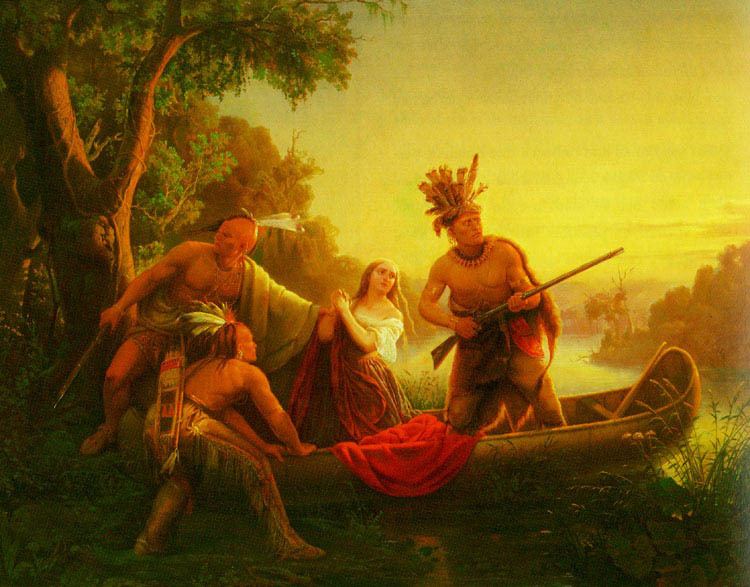 | ||
The capture and rescue of Jemima Boone and the Callaway girls is a famous incident in the colonial history of Kentucky. They were captured by a Cherokee-Shawnee raiding party and rescued by Daniel Boone and his party, celebrated for their success. The incident was portrayed in 19th-century literature and paintings: James Fenimore Cooper created a fictionalized version of the episode in his novel The Last of the Mohicans (1826). The incident was the subject of a painting entitled The Abduction of Boone's Daughter by the Indians (c. 1855) by Charles Ferdinand Wimar.
Contents
History
After the outbreak of the American Revolutionary War in 1775, violence increased between American Indians and settlers in Kentucky. American Indians, particularly Shawnee from north of the Ohio River, raided the Kentucky settlements, hoping to drive away the settlers, whom they regarded as trespassers. The Cherokee, led by Dragging Canoe, frequently attacked isolated settlers and hunters, convincing many to abandon Kentucky. This was part of a 20-year Cherokee resistance to pioneer settlement. By the late spring of 1776, fewer than 200 Americans remained in Kentucky, primarily at the fortified settlements of Boonesborough, Harrodsburg, and Logan's Station in the southeastern part of the state.
On July 14, 1776, a raiding party caught three teenage girls from Boonesborough as they were floating in a canoe on the Kentucky River. They were Jemima, daughter of Daniel Boone, and Elizabeth and Frances, daughters of Colonel Richard Callaway. The Cherokee Hanging Maw led the raiders, two Cherokee and three Shawnee warriors. The girls' capture raised alarm and Boone organized a rescue party. Meanwhile, the captors hurried the girls north toward the Shawnee towns across the Ohio River. The girls attempted to mark their trail until threatened by the Indians.
The third morning, as the Indians were building a fire for breakfast, the rescuers came up. As one Indian was shot, Jemima said, "That's Father's gun!" He was not immediately killed. Two of the wounded Native American men later died. The Indians retreated, leaving the girls to be taken home by the settlers.
Jemima married Flanders Callaway, who had been one of the rescuing party. Elizabeth Callaway married Samuel Henderson, and Frances married John Holder. The episode served to put the settlers in the Kentucky wilderness on guard and prevented their straying beyond the fort. Although the rescuers had feared the girls would be raped or otherwise abused, Jemima Boone said, "The Indians were kind to us, as much so as they well could have been, or their circumstances permitted." (Faragher, p. 140)
The Cherokee may have abducted the girls as a response to what they viewed as D. Boone's failure to observe Cherokee treaties. The Treaty of the Green River Wilderness promised Kentucky to Cherokee Tribe for "as long as the waters flow." Daniel Boone may have also been initiated into Cherokee Tribe as an adopted man. Daniel Boone may have also had Indian wives. The Cherokee claimed most of what is now called Kentucky, and some Cherokee Chiefs were from the region. Cherokee guides also assisted Boone at times in his early trips into Kentucky as trail guides or "trail bosses." Some Cherokee claim they showed Boone the way into Kentucky.
